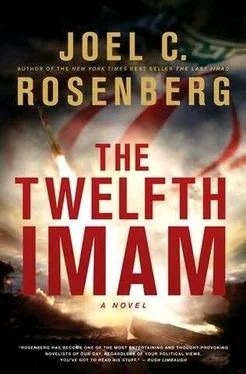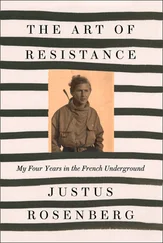“What is it?” the Supreme Leader asked, seeing Jazini’s face grow ashen.
“It is the Israelis, Your Excellency,” Jazini said.
Hosseini braced himself. “What have they done?”
“You’re not going to believe this.” Jazini proceeded to read the entire classified cable aloud.
“Russian intelligence indicates massive Israeli war game under way. Stop. Four hundred warplanes have been launched. Stop. Inbound for Greek isles for practice bombing, strafing runs. Stop. Repeat of their 2008 drill, but four times as large. Stop. FSB warns Jerusalem making final preparations for war. Stop. Please advise. Stop.”
Faridzadeh and Darazi gasped.
Hosseini was not surprised. Nor was he rattled like the others. It was time, he realized, to share with the men the vision he had just experienced and the message he had received.
“Gentlemen, we need not fear the Israelis, and let me tell you why,” the Ayatollah began. “Just before coming into this meeting, I received a message directly from the Twelfth Imam. In a vision not fifty yards from this room, he told me that the time for his appearance has come. The time of the extermination of the Israelis and the Americans has thus come as well. The Lord of the Age has chosen you and me to act, and we must be faithful. So get out your notebooks, and allow me to explain…”
Hamadan, Iran
It had rained most of the night.
But it wasn’t the storm that had kept Najjar awake, and even though the downpour had now stopped, he knew this would be another sleepless night.
He slipped out of bed, threw on some casual clothes and a jacket, and went out for a walk. The streets-abandoned and quiet-were slick, the air damp and brisk. A low fog had moved in across the city. Najjar zipped up his jacket and shoved his hands in his pockets to keep them warm. As he walked, he tried to reconstruct all that had brought him to this point.
He had been recruited by Dr. Mohammed Saddaji to come to Iran with three specific goals in mind, his marriage to Sheyda notwithstanding.
First, he was to serve as his father-in-law’s right-hand man at the Hamadan research facility. It had been an honor to help one of the world’s most gifted physicists create a civilian nuclear power industry for Iran that would be the envy of the world and a rebuke to her critics, especially the Americans and the Zionists.
Second, he was to serve as the primary liaison between Dr. Saddaji and the team of physicists working in the city of Bushehr to bring Iran’s first nuclear power plant online safely and efficiently. A man of Saddaji’s intellect and importance could not be bothered, after all, with constant phone calls, e-mails, and other interruptions from the Bushehr reactor. He needed someone to manage all of that, and for this he trusted Najjar implicitly. It was the combination of these two roles that had been so attractive from the beginning and that gave Najjar a level of intellectual stimulation and professional satisfaction he deeply appreciated.
But there was a third role for Najjar, and Dr. Saddaji had strongly implied that over the long term this would be his most important mission: to help train up a new generation of Iranian nuclear scientists by eventually-within the next few years-teaching at one of the country’s premier research universities. This was Najjar’s true passion. He longed to move Sheyda and their newborn daughter away from Hamadan, buy a home, and carve out a more stable life for his family. He knew he had to pay his dues, and paying his dues meant serving his father-in-law faithfully, but now he was beginning to question everything.
A lone car drove past, splashing water onto the sidewalks. Najjar ducked out of the way just in time, then turned down a side street and picked up the pace. The more he thought about it, the more trouble he was having with the notion that a UD3 expert had been operating inside a civilian nuclear research compound. It wasn’t just that the man was an Arab, though that was bad enough. The real concern was that the Times of London had published a highly controversial story in December 2009 alleging that Iran was engaged in trying to build a trigger for a nuclear bomb. The top-secret memo exposed in that article had been partly responsible for an international firestorm of criticism against the Iranian regime. It had caused the United Nations Security Council to consider imposing new economic sanctions against Iran. Normally Najjar and his colleagues had limited access to Western newspapers and the Internet due to their sensitive positions. Yet copies of this particular article-“Discovery of UD3 Raises Fears over Iran’s Nuclear Intentions”-had been passed around by Dr. Saddaji himself as “proof,” he’d said at the time, of a “Zionist campaign of lies and slander” against Iran’s “peaceful” nuclear program.
Najjar recalled a particular section from the article with crystal clarity. “Independent experts have confirmed that the only possible use for UD3 is as a neutron source, the trigger to the chain reaction for a nuclear explosion. Critically, while other neutron sources have possible civilian uses, UD3 has only one application-to be the metaphorical match that lights a nuclear bomb.”
That was true, Najjar knew. What’s more, any test explosion using UD3 would leave behind traces that would certainly be regarded as proof that Iran was building a nuclear weapon. There was no way, he was sure, his father-in-law would take such a risk.
At the time, Najjar had fumed that the entire article was built on lies. The Times reporter had quoted a “Western intelligence source”-someone who had to be from the Israeli Mossad, Najjar was convinced. It was all a plot by the Jews to subjugate the Persian people under Western colonialism and imperialism. He had passionately echoed his father-in-law, not because it was the party line but rather because Najjar believed it to be true. As Dr. Saddaji’s chief of staff, he personally knew-or knew of and controlled the personnel files for-every single nuclear scientist in the country. All 1,449 of them. He had pored over their files. He had pored over their security clearance dossiers. He knew all of their supervisors and was in direct contact with many of them. So he knew for a fact that not one of them- not a single one -was a specialist in uranium deuteride or titanium deuteride.
Now what was he to think? Dr. Saddaji had been keeping secret from him-his own son-in-law-the presence of an Iraqi UD3 expert in the Iranian nuclear program. The man had then proceeded to order the brutal execution of that expert without a trial, without even a hearing. Why?
What else was his father-in-law hiding? Was the man really running a civilian nuclear power program, as Najjar had thought from the beginning? Or was he actually spearheading a clandestine program to build a nuclear weapon, as the Americans and the Israelis claimed? It was beginning to look as if the latter was the case. If so, was this the real project for which Dr. Saddaji had recruited him, the one that would “change the course of history”? Was this actually the project that would “make way for the coming of the Promised One”?
Dubai, United Arab Emirates
It was late when “Reza Tabrizi” landed in Dubai.
He couldn’t wait to get to the hotel for a hot shower, a good meal, and a real bed. To maintain the fiction he had already set into motion, he traded phone numbers with Yasmeen, giving her his number in Munich, and headed toward passport control, reminding himself again and again that he was no longer David Shirazi. He was a successful German businessman of Iranian extraction. He wasn’t coming from Syracuse, but from a trade show in Chicago that had been a waste of time. He rarely went to the U.S., he reminded himself. Indeed, he disdained doing business with the Americans. They were too loud, too pushy, and too greedy, and there were far too many Jews. He repeated this to himself again and again. CIA protocols required him to have spent the transatlantic flight refreshing himself on his cover story and getting himself fully into his alias. But his mind had been elsewhere on the flight, and he was rapidly playing catch-up.
Читать дальше












